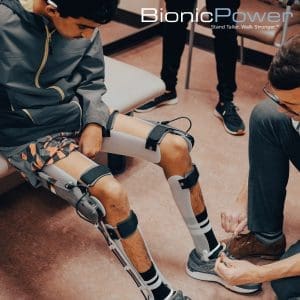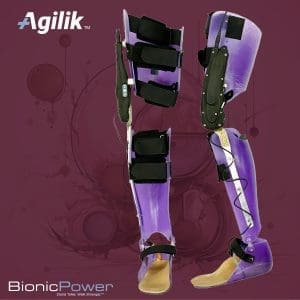Individuals with Spina Bifida can experience a range of challenges related to their mobility. Certain gait pathologies and their impact on the body, such as crouch gait, can cause damage over time that further complicates and impedes mobility in people with Spina Bifida as they age. Each case is unique and understanding an individual’s distinctive needs and symptoms is essential for providing optimal treatment and care. Bionic Power’s Agilik smart orthosis is one such therapeutic intervention for individuals with Spina Bifida who walk with crouch.
Crouch gait is shown in almost 30% of Spina Bifida cases(1). Keep reading to learn more about this condition and how to treat it.
What is crouch gait?
Crouch gait, also known as flexed knee gait, is characterized by an excessive flexion of the knee, hip, and ankle during the stance phase of walking. This gait pattern is commonly observed in individuals with Spina Bifida and other neuromuscular conditions such as cerebral palsy. It becomes particularly apparent post-puberty when one has experienced growth spurts. In such cases, their muscles may struggle to keep up with the increased body weight.
During the stance phase in typical gait, the knee fully extends, providing the person with support from their skeleton and not solely relying on muscle to keep their leg extended. However, individuals with crouch gait cannot fully extend their knee. This means that those with crouch gait rely solely on their muscles (not their skeleton) for support while walking, fatiguing and stressing their knees.
How does crouch gait affect people with Spina Bifida?
Crouch gait and associated symptoms commonly arise in children and adults with Spina Bifida. A group of orthopaedic surgeons and physical therapists concurred in a 2019 study in the Gait & Posture journal(2) that crouch gait is the most common gait pathology affecting those with Spina Bifida. This means that many ambulatory individuals with Spina Bifida experience difficulties associated with crouch gait, and due in part to the excessive strain on their muscles which work to compensate for the irregular function around their knee joint.
The location of the neural tube defect on a person’s spine is determinative of the symptoms they experience. If the neural tube defect is higher up on the spine, paralysis is more likely. If it is lower on the body near the hips or lower spine, the individual may walk with the assistance of a mobility device or on their own. Ambulatory people with Spina Bifida can improve and strengthen their gait through physical therapy and other therapeutic interventions.
A study of 852 U.S adults with Spina Bifida(3) found that of those surveyed, 36% primarily use a wheelchair and walk only therapeutically. Correcting crouch early in life can help alleviate the pain caused by muscles overcompensating during ambulation, especially during adolescence after the onset of puberty. Many of the adults using wheelchairs were able to walk earlier in life. If they had more options to help them walk more easily, they may have been able to keep walking for longer. Gait intervention and correction is a multi-step process tailored to the unique needs of each individual. One helpful step in determining a patient’s gait pathology and intervention needs is a computerized gait analysis.

The importance of computerized gait analysis(4)
Orthopedists and therapists can diagnose gait pathologies through clinical observation, a key component of pre-operative and pre-therapeutic planning for patients with Spina Bifida. Computerized gait analysis provides further insights into an individual’s gait, logging detailed data about how their joints and muscles are behaving during each phase of gait. Jointly with clinical observation, computerized gait analysis is essential for planning interventions and achieving lasting meaningful impacts to help people with Spina Bifida walk more comfortably.
Get lifted out of crouch with the Agilik
 An option that may alleviate crouch gait in individuals are devices like the Agilik. The Agilik is a robotic orthosis system tailored for gait training, offering both support and resistance in knee flexion and extension to address crouch gait throughout all walking phases. This helps users walk more independently and efficiently; notably, it does not completely take over walking or control the user’s movements.
An option that may alleviate crouch gait in individuals are devices like the Agilik. The Agilik is a robotic orthosis system tailored for gait training, offering both support and resistance in knee flexion and extension to address crouch gait throughout all walking phases. This helps users walk more independently and efficiently; notably, it does not completely take over walking or control the user’s movements.
Each Agilik is a unique device that can be tailored to the user’s needs. The patient’s orthotist, doctor, Bionic Power’s experts, and physical therapists collaborate to personalize, fine-tune, and put the device into action.
To learn more about the Agilik, and to see if it may be an option for you or someone you know, check out: https://bionic-power.com/agilik/
This blog was sponsored by: Bionic Power
(1) https://pubmed.ncbi.nlm.nih.gov/30321794/
(2) https://www.sciencedirect.com/science/article/abs/pii/S0966636218308646?via%3Dihub
(3) https://www.sciencedirect.com/science/article/pii/S1936657419301232
(4) https://journals.sagepub.com/doi/10.1007/s11832-009-0214-5#bibr23-s11832-009-0214-5